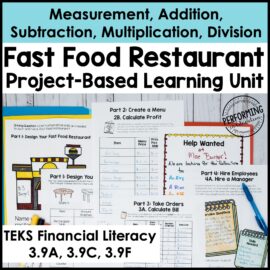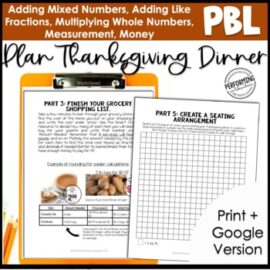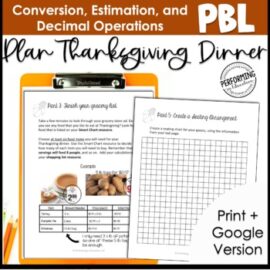The #1 concern I hear from teachers that want to implement project-based learning is that they just don’t have time to do PBL because they have so many standards to teach. There is good news for those teachers: Project-based learning can (and should!) be used to teach and apply your standards.
Included in this post are the ways that I plan my PBL activities around our standards.
Intentional Planning
My first year teaching, backwards planning was the in thing. They wanted us to look at the assessment first, and then plan the lesson from there. This taught me about the importance of the starting point of my planning. For project-based learning, I want you to start your planning process with one core standard.
What is a “core standard”? This is a big, chunky standard that you spend a lot of time on in your classroom. It’s something like main idea, fractions, or the scientific method. It’s a standard that the other standards in that subject area feed into.
Choose one single core standard and search for a real life scenario that uses this standard. For fractions, one of my favorite scenarios is planning the recipes for a family Thanksgiving dinner.
Next, brainstorm the related standards and skills that relate to this scenario. PBL should include multiple standards and skills, all spiraled into the process of in-depth inquiry.
Once you have this information, head over to download the free planning guide. Follow the directions inside to plan all of the elements of project-based learning into the standard-aligned lesson you have laid out.

Mini-lessons
I know what you’re thinking. “But when do I TEACH these standards and skills?” There are a couple of schools of thought on this question. Many believe that students will figure out the skills on their own through the in-depth inquiry, and this is sometimes true. I strive for my students to stumble upon knowledge on their own. I model and reward persistence, problem-solving, and critical thinking. However, some of my students still struggle.
My school of thought is that it is 100% ok to give direct instruction during project-based learning. I try to be as hands-off as possible, but I still want to give my students the tools they need to be successful. Sometimes direct instruction is necessary.
I try to focus my direct instruction during PBL, so that it’s given in small groups or 1-on-1, but I also incorporate whole group mini-lessons. I use these to give my students notes and model examples of new concepts.
Here’s an example:
Project: Open a Fast Food Restaurant (Math-Focused With Business Connections)
Standard/Skill: Unit Rates (hourly wages)
Whole Group Mini-Lesson: 15-20 minutes
- Define unit rates.
- Give real world example.
- Explain how it will be used in the next part of our PBL.
- Give students tool for looking up minimum wage in our area.
- Direct students to their notes from our multiplication mini lesson.
Small Groups
The fact that project-based learning allows for me to easily meet with small groups of students still amazes me. I use small group within project-based learning to not only help my struggling students, but to challenge my high achievers.
I recommend that you plan for small groups every day by writing down questions you can ask students about the PBL that will help them in their inquiries. Use challenging questions with your high-fliers and guiding questions with your students that are stuck.
When you’re not pulling small groups, conference with individual students, encourage critique & revision, and ask students to reflect on their decisions. Project-based learning is an amazing opportunity to do these things!
Don’t forget to grab your free planning guide!





